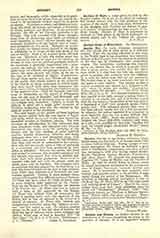

Ancona, CIRIACO D’, an Italian antiquary, whose family name was Pizzicolli, b. at Ancona about 1391; d. about 1455 at Cremona. During voyages of commerce throughout the Orient he collected a great store of inscriptions, manuscripts, and other antiquities, returning in 1426 after having visited Rhodes, Beirfit, Damascus, Cyprus, Mitylene, Thessalonica, and other places. He enjoyed the patronage of Eugenius IV, Cosmo de’ Medici, and the Visconti of Milan. In 1443 he visited Mores in Greece, where he copied inscriptions mentioned in the correspondence of Filelfo, Traversari, Leonardo Aretino, and others. He is accounted the best equipped, most learned, and accurate worker in the province of epigraphy during the period of the Renaissance. His accuracy in copying ancient inscriptions is said by De Rossi (op. cit. below, 377) to be “the chief credit and undying glory of Ciriaco”. Most of his manuscripts have been lost; those published after his death are “Itinerarium” (Florence, 1742); “Epigrammata reperta per Illyricum a Kyriaco Anconitano” (Rome, 1664), the latter very rare. Mazzuchelli mentions other works in his “Scrittori d’Italia” (s.v.).
THOMAS WALSH

